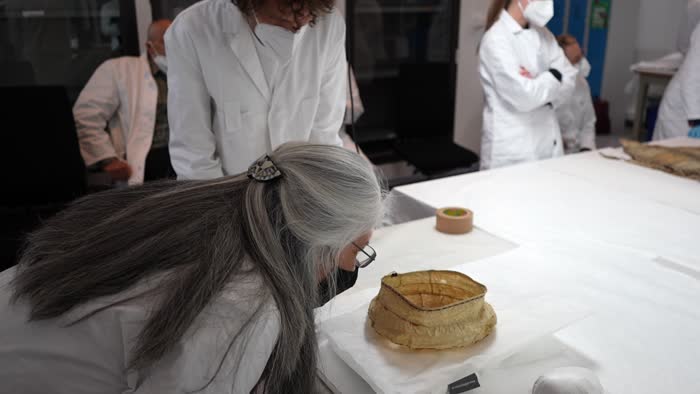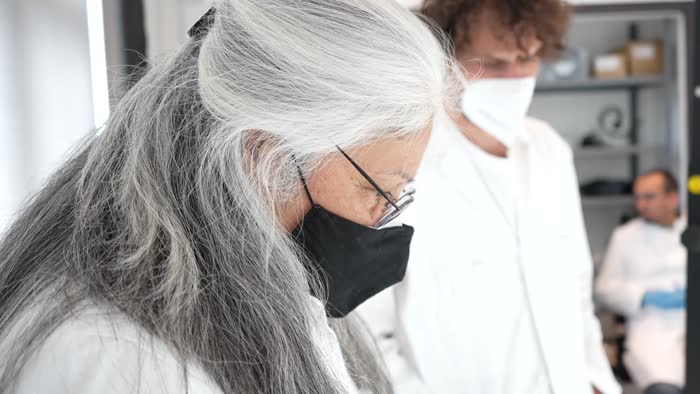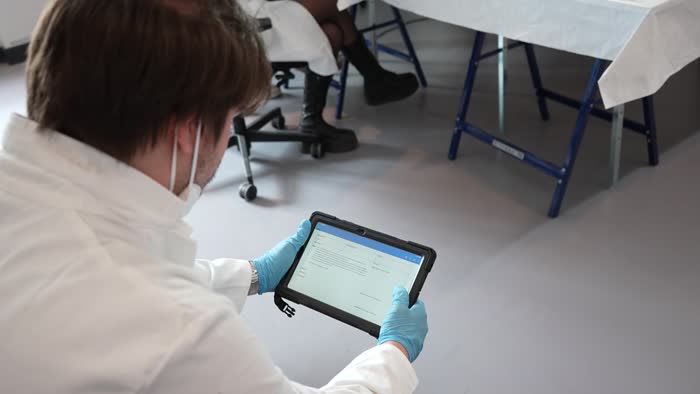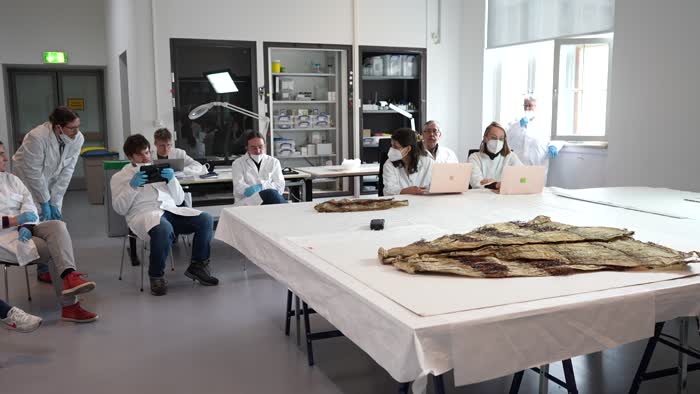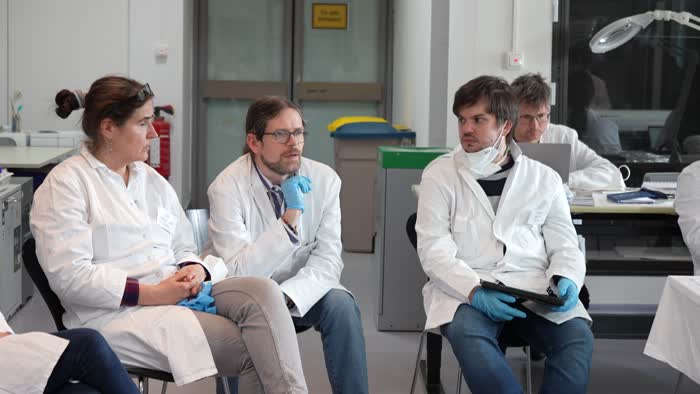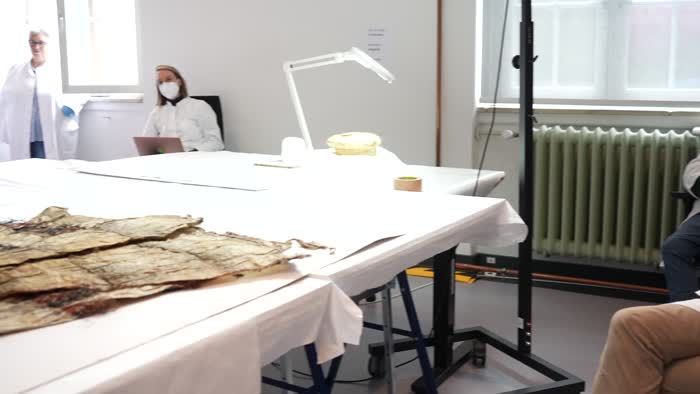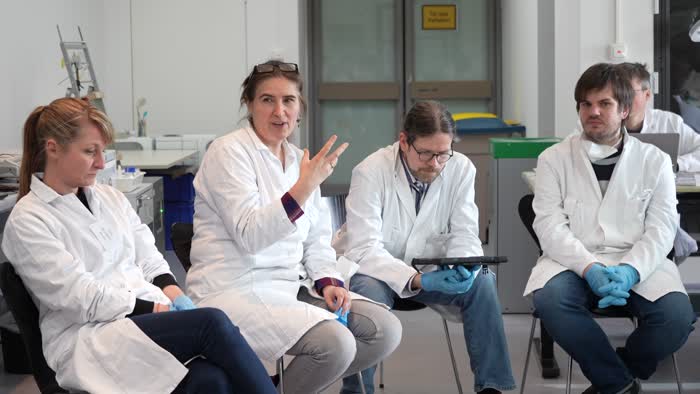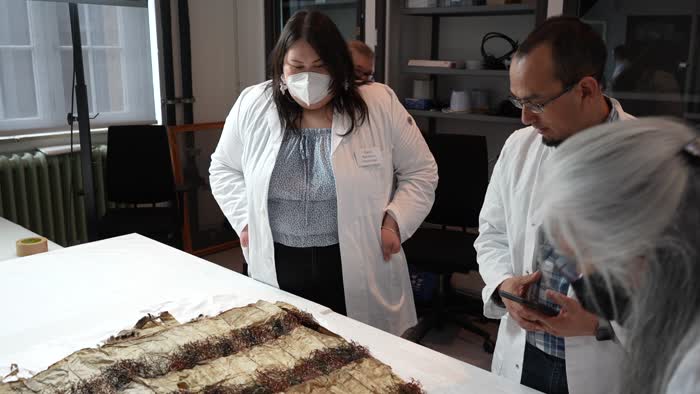Berlin Ethnological Museum 4.27.23
Berlin Ethnological Museum (Contributor)
Chugach Alaska Corporation (Contributor)
Chugach Heritage Foundation (Contributor)
Brandon Moonin (Contributor)
Dawn Randazzo (Contributor)
Deborah McMullen (Contributor)
William Smith (Contributor)
Pamela Smith (Contributor)
Chugach Alaska Corporation (Contributor)
Chugach Heritage Foundation (Contributor)
Brandon Moonin (Contributor)
Dawn Randazzo (Contributor)
Deborah McMullen (Contributor)
William Smith (Contributor)
Pamela Smith (Contributor)
Ethnological Museum of Berlin Repository
Chugachmiut Heritage Repository
The Berlin Ethnological Museum
Chugachmiut Heritage Repository
The Berlin Ethnological Museum
Dawn Randazzo: Vertical seams are not a regular waterproof stitch, and without grass sewn in, but the horizontal seams are like the bear gut coat she saw before. You can see the use of different waterproof stitches. when the gut is dry it is more brittle, but when wet it is more elastic. The material is meant to be wet. In the wet form is becomes more like rubber. You start with it raw. There's the outside layer, middle, and inside layer - scrape away the outside and inside layers to leave the middle layer behind, which is the waterproof layer. Then you dry it, harden it, and then you wet it again to use it.
Linsey Drury: Coat and Skirt of sea lion gut
Ute Marxreiter: Index card says that the fringe is made of pieces of stomach skin that is dyed.
Dawn Randazzo: Suggests that the fringe is sinew because it has the same texture as the rest of the cloak. Intestine expands and responds to moisture. Traditionally porpoise sinew would be used for sewing, also deer sinew but that is non-traditional as deer were imported to Alaska.
Dawn Randazzo: Some of the stitches on the skirt are waterproof, but not all of them.
Tatianna Turner: Could have been ceremonial as there are no arm holes. Does not seem to be for hunting or everyday use.
Dawn Randazzo: Princess Luise ship that collected this in the 1830s. (From Alutiit Sugpiat book)
Julian Bendel: Index card: The skirt is to be worn under it. Coat is worn as an overcoat to protect from rain. (Text by Jacobsen from 1883)
Index Card: Worn over the underclothes, and used among groups further south as well. Can be worn as a coat and thrown over the shoulder. No longer in use by the 1880s. Was used by "half-bloods" over cotton skirts. Jacobsen says these were not used by women. The smaller skirt is used as a skirt for Baidarka (three person qayaq).
Dawn Randazzo: You can see how this is reflective of creole culture.
William Smith: Heritage Kits include a sample video on how to do the waterproof stitching.
Dawn Randazzo: This stitch is different than the one that we learn in our heritage kits, which is interesting.
William Smith: Different people sewing had different methods within the overall system, there are other ways to do the waterproof stitch than are captured in the heritage kit. Every article that has been picked up is just a snapshot in time. Different sewers can sew the same thing, there are different ways to do waterproof stitching. You can put your personal spin on it, especially if it is decorative stitch. Stitches can be a decorative marking.
William Smith: To hunt sea otters, you want the biggest pelt, so you want the males. To harvest them you whistle at them, and this makes them perk up their heads which gives you the perfect shot.
And there were many ways to stitch a waterproof stitch that could work well. Hunting techniques evolve with time. Sometimes our children are smarter than we are. You want to respect the animal and harvest it without causing it unnecessary pain.
Dawn Randazzo: The cloak could be made out of brown bear, it's thicker than seal.
William Smith: Some of the hunters are experimenting with dyeing sea otter.
Brandon Moonin: Possible dyes could be red ocre mixed with whale or seal oil.
Deborah McMullen: I'm sure different kinds of rocks were used. And "the original essential oils".
William Smith: Red dye was made from blood root.
Brandon Moonin: Charcoal and pines were used for tattoos. Soot and charcoal, red ocre were used for tattoos.
Deborah McMullen: There is a resurgence now of traditional face tattoos as well. I've never seen a skirt before, but during that time, if it was mainly for the Creoles, the Russian man would want his lady to look as nice as possible.
Deborah McMullen: If it was mainly for the creoles, the hat was copying some of the women that were coming of these boats. The Russian men surely wanted there women to look nice.
Dawn Randazzo: It imitates the Russian coats and so is an expression of creole culture. This is very much Kodiak style.
Pamela Smith: the way the collar is sewn is the most interesting part of it.
Dawn Randazzo: You can tell the difference in thread on the skirt. They stitched it back together in different ways.
Linsey Drury: Coat and Skirt of sea lion gut
Ute Marxreiter: Index card says that the fringe is made of pieces of stomach skin that is dyed.
Dawn Randazzo: Suggests that the fringe is sinew because it has the same texture as the rest of the cloak. Intestine expands and responds to moisture. Traditionally porpoise sinew would be used for sewing, also deer sinew but that is non-traditional as deer were imported to Alaska.
Dawn Randazzo: Some of the stitches on the skirt are waterproof, but not all of them.
Tatianna Turner: Could have been ceremonial as there are no arm holes. Does not seem to be for hunting or everyday use.
Dawn Randazzo: Princess Luise ship that collected this in the 1830s. (From Alutiit Sugpiat book)
Julian Bendel: Index card: The skirt is to be worn under it. Coat is worn as an overcoat to protect from rain. (Text by Jacobsen from 1883)
Index Card: Worn over the underclothes, and used among groups further south as well. Can be worn as a coat and thrown over the shoulder. No longer in use by the 1880s. Was used by "half-bloods" over cotton skirts. Jacobsen says these were not used by women. The smaller skirt is used as a skirt for Baidarka (three person qayaq).
Dawn Randazzo: You can see how this is reflective of creole culture.
William Smith: Heritage Kits include a sample video on how to do the waterproof stitching.
Dawn Randazzo: This stitch is different than the one that we learn in our heritage kits, which is interesting.
William Smith: Different people sewing had different methods within the overall system, there are other ways to do the waterproof stitch than are captured in the heritage kit. Every article that has been picked up is just a snapshot in time. Different sewers can sew the same thing, there are different ways to do waterproof stitching. You can put your personal spin on it, especially if it is decorative stitch. Stitches can be a decorative marking.
William Smith: To hunt sea otters, you want the biggest pelt, so you want the males. To harvest them you whistle at them, and this makes them perk up their heads which gives you the perfect shot.
And there were many ways to stitch a waterproof stitch that could work well. Hunting techniques evolve with time. Sometimes our children are smarter than we are. You want to respect the animal and harvest it without causing it unnecessary pain.
Dawn Randazzo: The cloak could be made out of brown bear, it's thicker than seal.
William Smith: Some of the hunters are experimenting with dyeing sea otter.
Brandon Moonin: Possible dyes could be red ocre mixed with whale or seal oil.
Deborah McMullen: I'm sure different kinds of rocks were used. And "the original essential oils".
William Smith: Red dye was made from blood root.
Brandon Moonin: Charcoal and pines were used for tattoos. Soot and charcoal, red ocre were used for tattoos.
Deborah McMullen: There is a resurgence now of traditional face tattoos as well. I've never seen a skirt before, but during that time, if it was mainly for the Creoles, the Russian man would want his lady to look as nice as possible.
Deborah McMullen: If it was mainly for the creoles, the hat was copying some of the women that were coming of these boats. The Russian men surely wanted there women to look nice.
Dawn Randazzo: It imitates the Russian coats and so is an expression of creole culture. This is very much Kodiak style.
Pamela Smith: the way the collar is sewn is the most interesting part of it.
Dawn Randazzo: You can tell the difference in thread on the skirt. They stitched it back together in different ways.
Measurements: a: 126 x 103 x 10 cm, b: 41 x 63 x 7 cm
Weight: < 2 kg
Weight: < 2 kg
Do you have a story to contribute or a comment about this item?
Login/register to comment 1881 – 1883
Feathers
IV A 86 a,b
Copyright 2023 Chugachmiut Heritage Preservation
Present
Kodiak Island (Related)
